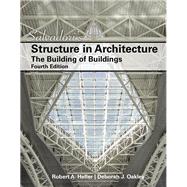An excellent text as a first introduction to structures geared toward architecture students, or as a companion for more traditional engineering / math-based courses including statics and strength of materials or structural principles.
This conceptual, non-mathematical, yet technical look at the principles of structural mechanics, and the physical properties of building elements makes structural mechanics for architecture accessible to all.
Continuing Dr. Salvadori’s passion for education and an accessible non-mathematical presentation of structural mechanics, Salvadori's Structure in Architecture: The Building of Buildings, 4/e is a must-have for students of architecture and building construction, structural engineers, and all those with an interest in architecture. It has been revised and expanded to include over 500 new illustrations, 150 new photos, and new materials covering the changes in technology and construction techniques developed during the last 50 years. Now presented in three manageable sections covering the fundamental concepts (Section 1), structural forms (Section 2), and topics beyond the basics (Section 3), it provides expanded content and graphics on critical topics such as beam behavior, moment of inertia, redundancy and much more!








